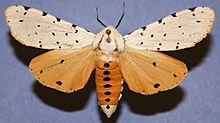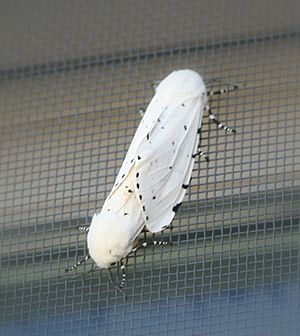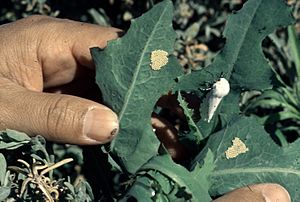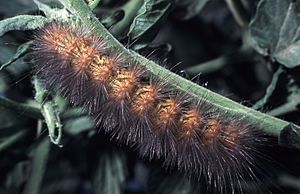Salt marsh moth facts for kids
Quick facts for kids Salt marsh moth |
|
|---|---|
 |
|
| Scientific classification | |
| Kingdom: | |
| Phylum: | |
| Class: | |
| Order: | |
| Family: | |
| Genus: |
Estigmene
|
| Binomial name | |
| Estigmene acrea |
|
The salt marsh moth or acrea moth (Estigmene acrea) is a type of moth found in North America. It belongs to the family Arctiidae. When it is a caterpillar, it is known as the 'salt marsh caterpillar'.
Contents
What the Salt Marsh Moth Looks Like
The moth's head and the part of its body where its legs and wings are attached (called the thorax) are white. Its main body section (the abdomen) is yellow-orange and has a line of black spots. The top wings (fore wings) are white. They can have different amounts of black spots, and some moths might not have any spots at all.
The bottom wings (hind wings) are yellow-orange in male moths. In female moths, these wings are white. Both male and female moths have 3 or 4 black spots or larger marks on their hind wings. The distance from one wingtip to the other (its wingspan) is about 4.5 to 6.8 centimeters.
When and Where They Fly
You can usually see these moths flying from May to August. However, in warmer places like southern Florida and southern Texas, you might see them all year long.
The Salt Marsh Moth Life Cycle
The eggs of the salt marsh moth are yellowish. The female moth lays them in groups, or clusters, on the leaves of the plants where the caterpillars will eat.
The salt marsh caterpillar can look very different from one to another. Their color can range from light yellow to dark brownish-black. They are covered in many soft hairs. These hairs are longer near the end of their body. The segments of their body (the thorax and abdomen) have a few rows of bumps, called warts, which can be either orange or black.
After the caterpillar stage, it turns into a chrysalis. The chrysalis then spends the winter resting inside a cocoon. This resting period is called hibernation.
Plants They Eat
The salt marsh caterpillar eats many different kinds of plants. Here are some of the plants they like to feed on:
- Cabbage
- Cotton
- Walnut trees (Juglans species)
- Apple trees (Malus domestica)
- Tobacco plants (Nicotiana tabacum)
- Pea plants (Pisum sativum)
- Potato plants (Solanum tuberosum)
- Clover (Trifolium species)
- Maize or Corn (Zea mays)
Images for kids





